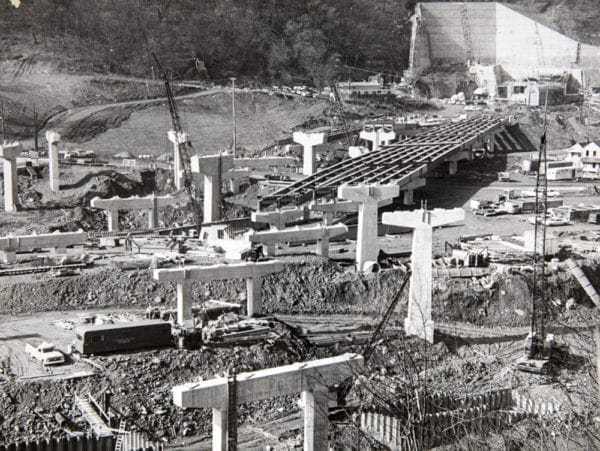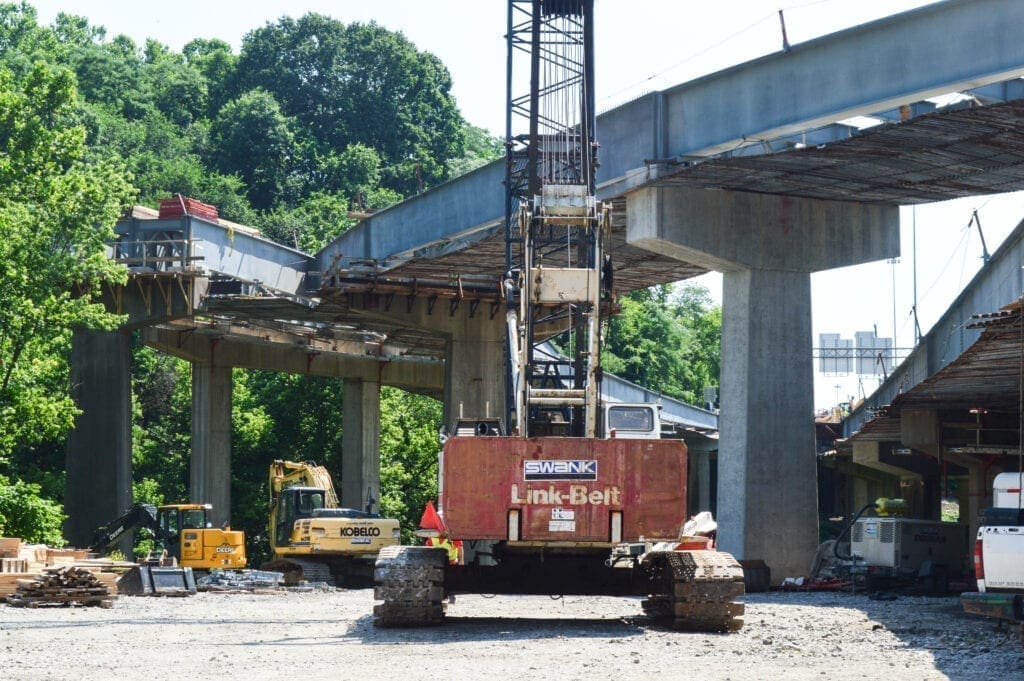“Why else would it go to just one lane?”
“The arch should be closer to Wheeling Island, not downtown.”
And so on, and so on. The urban myth has been around for decades, and it’s surfaced again since the span is currently undergoing its first major renovation since the mid-1990s. Steel repairs, pier reinforcement, the re-decking of the westbound and eastbound lanes, and a paint job have been ongoing since November 2019, and they are scheduled to continue for at least another year.
So, was the Fort Henry Bridge installed backward when it was constructed and opened in the mid-1950s?
When asked in 2021, former Division of Highways district engineer in the Northern Panhandle, Tony Clark replied, “What do you mean?”
Well, were the blueprints upside down? Was the west side of the design turned to the east? Because the bridge was constructed 40 years before the condition “dyslexia” was a well-known diagnosis in the United States, so could the condition have played a factor?

“I have never heard that before, so I seriously doubt that’s the case. Just from an engineering standpoint, we don’t like things being wrong, and I’m sure that if it was installed the wrong way, it would not be just a rumor,” Clark said. “In order for that to happen, it would have had to been designed wrong, and that would have been a pretty huge mistake that hasn’t been documented since.
“With that said, the bridge is a rarity because Interstate 70 continues in only one lane, but I have no reason to consider that it was put in backward,” he said. “It was built before I was born, but it sure appears to fit just fine. Maybe some of the people who helped build it started that tale, but as far as I know, there’s no truth to it.”

Expect the Worst
The Velotta Construction Company was awarded a $7 million bid for the renovation of the two tubes of Wheeling Tunnel. The project was scheduled to begin in early 2007 and it was expected to last only six months.
It lasted three years. The new tiles had to be ordered from Germany, and that caused delays. Then, those tiles wouldn’t stick because of bad glue.
That is why confidence was very low among Wheeling area citizens when Swank Construction crews arrived in Wheeling to begin the $214 million “Roads to Prosperity” project that included 26 bridges and ramps along I-70 in Ohio County. The fact the Fort Henry was one of the many spans that were addressed provoked the regurgitation of the urban myth.
“I have heard that my entire life,” said former Ohio County Sheriff Tom Howard. “It’s not true, but some people still believe it.”
But why?

“It could be because the superstructure of the Fort Henry Bridge is so close to downtown Wheeling, but it is where it is because that’s the area where the river is the deepest along the front channel,” Clark explained four years ago. “It also could be because where the supports are for the Suspension Bridge, because there’s a lot more to that bridge than people can see.
“I’m only speculating about those reasons based on what I have seen, but the piers are where they are for a reason, and the people who designed it and constructed it went by those kinds of things,” he said. “But again, I have never heard that the Fort Henry Bridge was put in backward, and I am sure I would have by now.”
Certainly, Swank officials would have recognized it, right?
“(When) the I-70 projects (were) taking place and a lot of work (was) being done to the bridge, I’m sure the people with Swank had some questions if that was true, but nothing (was) said,” Clark said with a chuckle. “The bridge has lasted a lot of years, so I’m pretty sure those folks knew what they were doing.”

Ramps to Nowhere
Some legends are true.
The Fort Henry Bridge was completed a decade before Wheeling Tunnel opened in December 1966. The Peninsula Cemetery was split, and more than 300 burials had to be relocated to new resting places. And yes, an entire neighborhood known as “Goosetown” was destroyed to make way for what was supposed to be a W.Va. Route 2 bypass around downtown Wheeling.
The state highway, which runs from Hancock to Cabell counties, still flows along Main and Market streets in downtown Wheeling because such a sidestep roadway never materialized.
Hence, the ramps to nowhere.
“And I know that the ramps to nowhere were constructed because of a plan to make W.Va. Route 2 bypass downtown Wheeling completely, but that the project didn’t go the way the original designs were designed,” Clark explained. “It was about connecting to I-70 and about taking the state highway to the north from there, but it never happened. As far as the I-70 projects, the original plan was to eliminate those ramps, and the architects tried to make that happen, but they couldn’t figure it out in a cost-effective way.
“Based on the designs, removing those ramps would have meant a completely new design and a costly effort to remove them, and it just made financial sense to leave it in place,” the former district engineer added. “So, the ramps to nowhere didn’t go anywhere.”



Great story 👏